Yesterday morning I was able to get my first glimpse of the chicks of the nesting Red-tailed Hawks I’ve been watching since early spring.
Many readers have been asking to see photos of them so I decided to comply with those requests. These images were taken from far away with a super-telephoto lens (effectively at 1120mm) and have been cropped significantly (I never closely approach nests) so the image quality isn’t particularly good but I think they’ll satisfy some of the curiosity and interest expressed by many blog followers.
This photo of the apparently incubating female was taken on April 15. I’ve included it here for a reason.
Notice how clean the rocks below the nest are. Newly hatched chicks are tiny and helpless (altricial) so especially at this fairly steep angle I could never see them in the bowl of the nest at that age but when they’re a little older they instinctively begin to move to the periphery of the nest and defecate over the edge for sanitary reasons.
This is what the rocks below the nest have looked like for many weeks but lately I’ve been watching carefully for the telltale signs of active chicks that I might be able to actually see.
And this is what those rocks looked like yesterday. Notice the spots of white uric acid indicating that chicks have recently begun to poop over the nest edge. It appears to me that in their early attempts to do so they defecated from a safer spot at the left edge of the nest which caused the uric acid to splatter against the rocks behind them.
Yesterday morning when I spotted this evidence of more active chicks I decided to hang around for a short time and see if I could eventually see any little white heads poking up.
It didn’t take long. This was my first view of one of the young chicks.
And eventually there were two. Two was all I saw though it’s possible there were more – clutch size for Red-tailed Hawks is usually 2-3 eggs and sometimes 4. While I was there neither chick came to the edge of the nest to poop so this is the best look at both of them I was able to capture.
1/2500, f/7.1, ISO 500, Canon 7D Mark II, Canon EF 500mm f/4L IS II USM + EF 1.4 III Extender, not baited, set up or called in
And this is how it all began way back on March 29 when I photographed the two adults mating on a rocky point near the almost completed nest.
For me it was a special experience to see the mating behaviors that eventually resulted in chicks that I’ve also been able to observe and document. Being witness to this much of the entire life cycle of such a magnificent raptor means a lot to this old zoologist and bird photographer.
The photos were a huge bonus of course but even without them it would have been an extremely fulfilling experience. I suspect most of my readers will understand why.
Ron
Note: I want to make it clear that whenever I’m in the general vicinity of the nest I watch very carefully to make sure my presence doesn’t disturb the hawks or alter their behavior. If it did I’d leave the area immediately. But the nest is near a road, the hawks have become acclimated to traffic and I never get out of my vehicle. At this point I almost think the hawks see my silver pickup as part of the landscape…


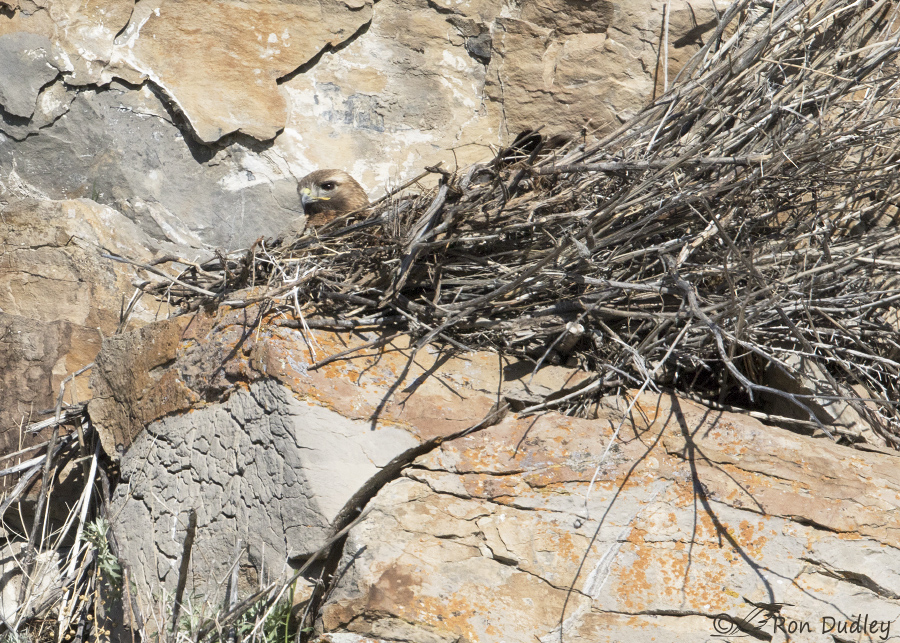
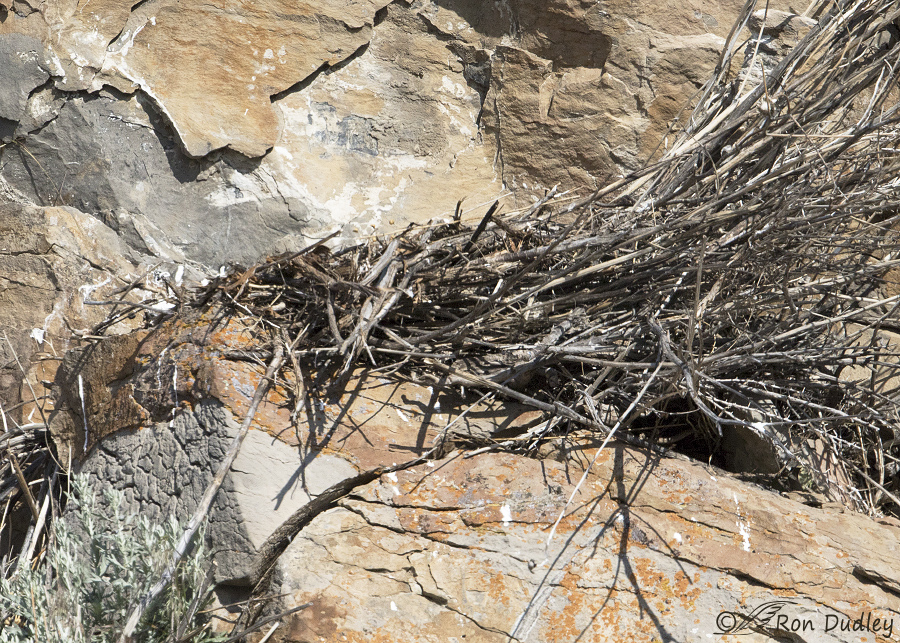
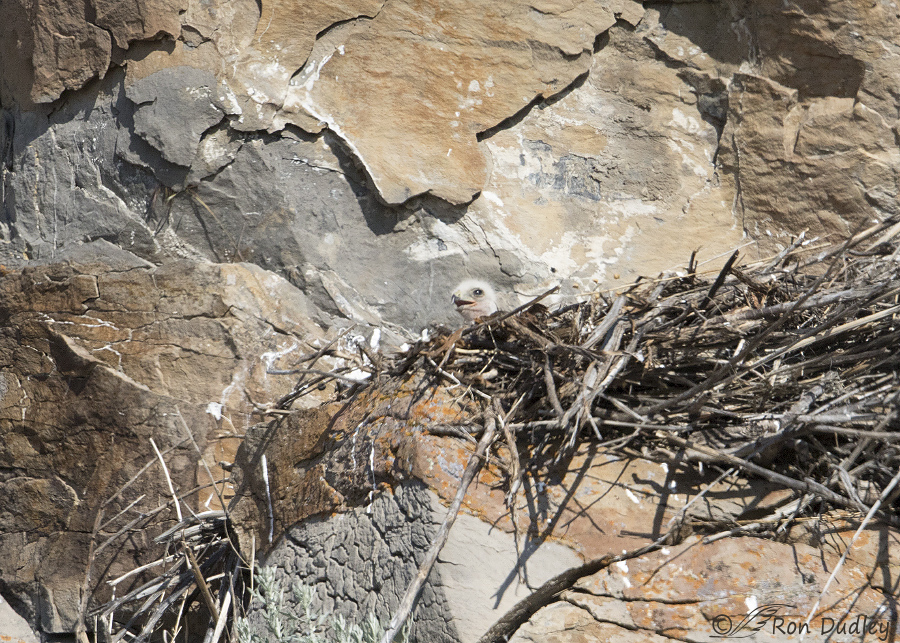
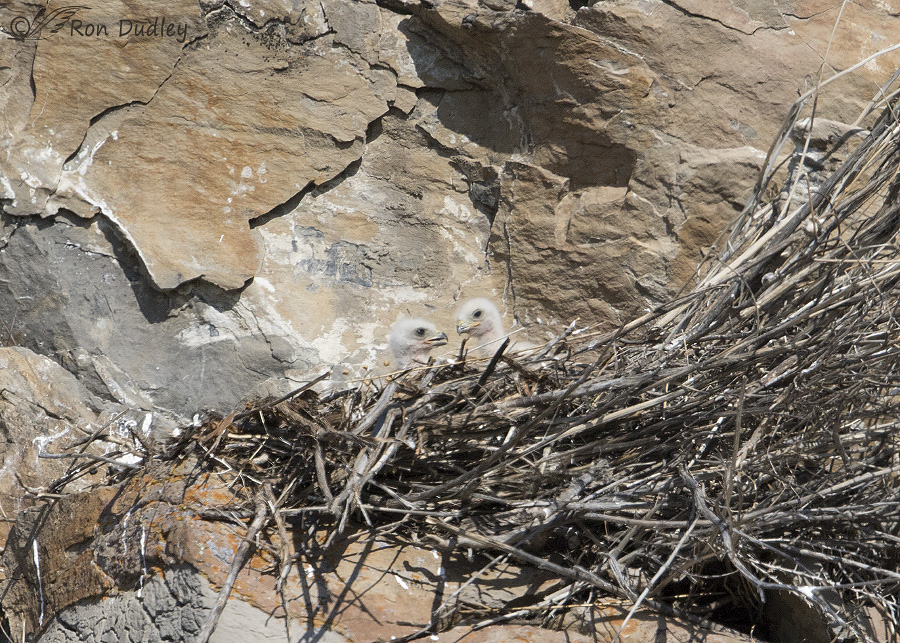
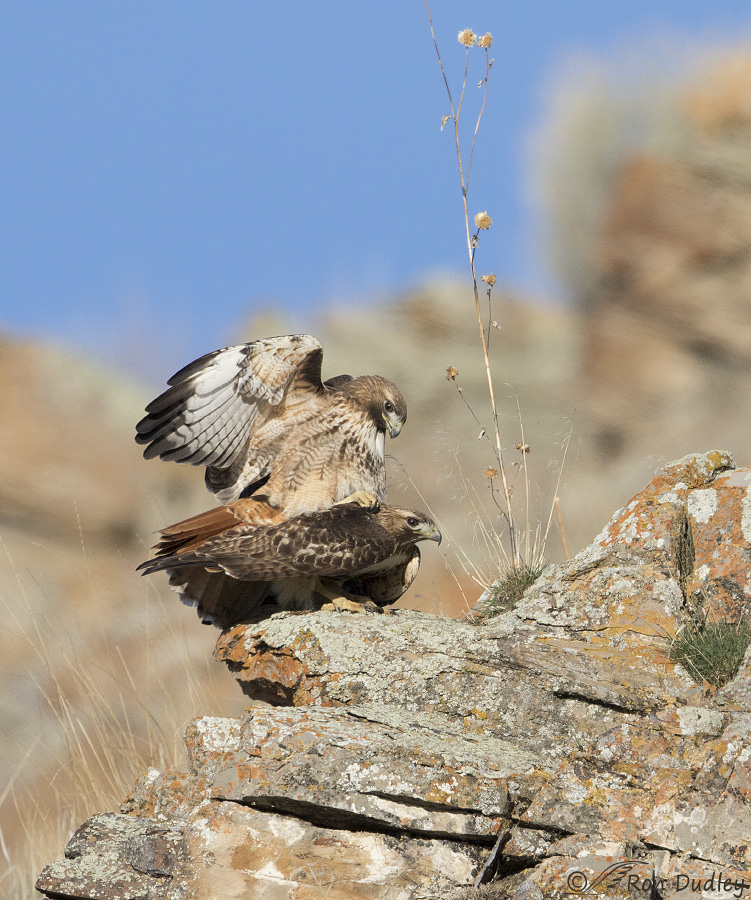
Ron,
Great “story.” Thanks for the pics.
Stephen
We have all been eagerly anticipating the first view of the chicks. Thanks for continuing to update us on their progress!
Wonderful Ron!
Wow now that is totally amazing to see Ron! Those fuzzy white baby heads. 🙂 So cute. I have seen a lot of mating birds but never a hawk. You outdid yourself on the pics…..really great! Thank you!
I’m glad you like them, Barby. Thanks
My goodness, new life in the spring is such a wonderful thing. It would seem that birds spend a lot of time with their eggs, building a nest and caring for and feeding the chicks. Their dedication to their young is heartwarming and learning about it makes me happy.
Thank you so much for sharing this story with us through your wonderful photos and narrative. Your dedication is remarkable.
They spend a lot of time at it indeed, Alice. It takes an incredible amount of work and I’m always impressed by their dedication whenever I see any part of the process.
WHAT a privilege to see. And share.
Megathanks. As always.
Thank you, EC.
Wonderful shots of the mating and then the chicks. I never fail to be moved by seeing chicks and having you include the mating photo was a bonus. As always, Ron, thank you for your talent and persistence. I know you would never get close to the birds you photograph.
Thanks for your confidence in me, Diana. Part of my motivation is probably selfish though – it’s seems counterproductive for a bird photographer to do anything that might lead to preventing successful reproduction of his/her subjects.
It’s very kind of you to share these images. Thank you.
Thanks, Arwen.
Oh how I love the fuzzball bobblehead stage! THANK YOU so much for getting these shots. You ROCK!
In watching the Cornell kiddos, they backed up to the edge of the nest from their first poop. The first try didn’t make it over the edge, but they were clearing the edge of the nest cup (the inner bowl where the little ones stay for the first week or so) by the second or third try. I found that absolutely amazing since they’re not that mobile in the first days, but they made THAT happen.
I visited my local nest yesterday, stopping on the side of the road. In the glances I got driving by, I thought there were only two, however, when I stopped for awhile, there were three! I was delighted. And they’ve reached the stage where Mom is willing to leave them somewhat (closely) unsupervised for short periods of time. Mom perched two poles west of the kiddos and kept an eye on the goings on from there.
Laura, both parents of these chicks are already leaving them alone in the nest for extended periods of time now. I think they know that nest is in a pretty safe location, at least from ground predators.
With the nest here, Mom didn’t have to do much brooding because of the warm weather, so she’s either been perched just above the nest or nearby. And given that she has a full 360-degree view of the nest, any avian predators can be dealt with long before they can threaten the kiddos. It’s such a delight to see them thriving…of course, there is an abundance of prey here, so it shouldn’t be an issue.
I love nesting season for everybody out there. And I really miss watching the Cornell hawks up close. But there’s hope for next year. Big Red appears to be grooming a young, first-year male now. The next chapter of this story will be interesting. 🙂
When you said yesterday was a beautiful day out there I was excited to see what you would post today. You did have a wonderful day, what adorable fluff balls with talons. I have been anticipating some little heads poking up soon on a nest I have been watching. The nest bowl is deep so it might be a while. Like you I do not disturb or get even close, when other cars go by I pull my camera in and look down at a map in my lap. I must look so lost I recently had a local stop and ask if I need help. Nice to know I am being watched over!
April, I’ve also had locals on that road stop and ask if I needed help in the past but now most of them recognize me and know what I’m doing so they don’t ask anymore. With the exception of one person they all seem to be nice, friendly folks. I’ve met several of them – including the “goat guy” who we really like. He does love those goats!
Awwwwwwwesome! I’m thrilled to know they are thriving in this location — congrats to you on these wonderful images (love the catchlight in chick #1’s eye!) and to the parents on their handsome (and cute) brood. I
Chris, I tried hard to get a catch light in the eyes of BOTH chicks but it just didn’t happen…
Wonderful pics of these chicks! Love the grebe chick pics too! Thanks again for sharing!
Thanks, Joanne.
This series brings on a big ol’ goofy grin and a happy tear to my eye. A perfect start to my morning — before and after shots. Too. Damn. Cute. 😀
Good, a goofy grin is a good thing, Marty!
Great fun and shots, Ron. Watching the young rapidly progress from “fuzzballs” to fledglings and one is a wonderful experience.
It certainly is, Judy. Thanks.
I love that you’ve been able to catch the chicks as well as the behavior that produced them. I’m looking forward to seeing those chicks grow up.
Thank you, Susan.
Ron, Mia…
When we moved up here from Florida in 1959, the very first hint of morning light initiated a rising crescendo of bird calls and song that could best be described as a “din”. Overnight visitors from the city complained about “all that incredible noise”. This morning…yesterday…the day before that..(and how many mornings before that?) …SILENCE! . We have nest boxes and feeders in both the front and the back yards that used to be mobbed by a variety of hungry, breakfast-seeking birds…this morning, the start of a sunny day, there were—none. I loved watching the birds fly over the skylight…one of the main reasons we had skylights installed…This morning, again, I saw none. Finally, by about 8 am, I thought heard the distant call of a single mourning dove. How appropriate! It’s happened, Rachel…..
Sounds ominous, Patty…
Scary as hell!!!
It never occurred to me that a raptor could ever be anything but dignified and fearsome…….but I had to emit an ” awwwww” over your images this AM. The chicks are, for however short a time,
actually “cute”—WHAT IS IT about baby animals that make us react like that to the sight of them ?
Yeah, those little ones always seem to tug a heartstring, don’t they, Kris…
Nothing cuter than a nestling raptor! Thanks for the great series, Ron… I am looking forward to see more of this family.
As am I, Nancy. Thanks.
Excellent shots Ron!
It will be fun watching the chicks develop.
Is it an optical illusion or is the nest really large? The actual nest seems to be to the left, whereas the mass of sticks seem to be to the right.
Dick, It’s kind of a strange looking nest. It appears that the hawks draped the long ends of many of the sticks in the same direction (north) and those ends sweep upward. In other photos of the entire nest it looks even more “lopsided” than it does here.
And yes, it’s a pretty large nest.